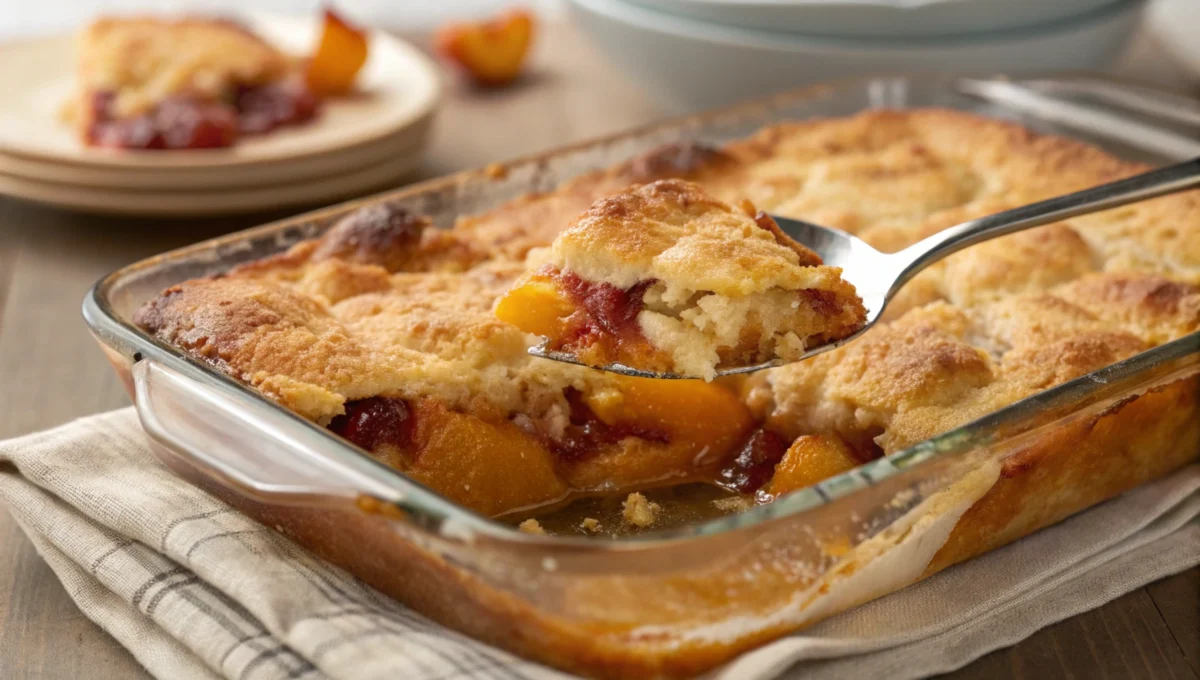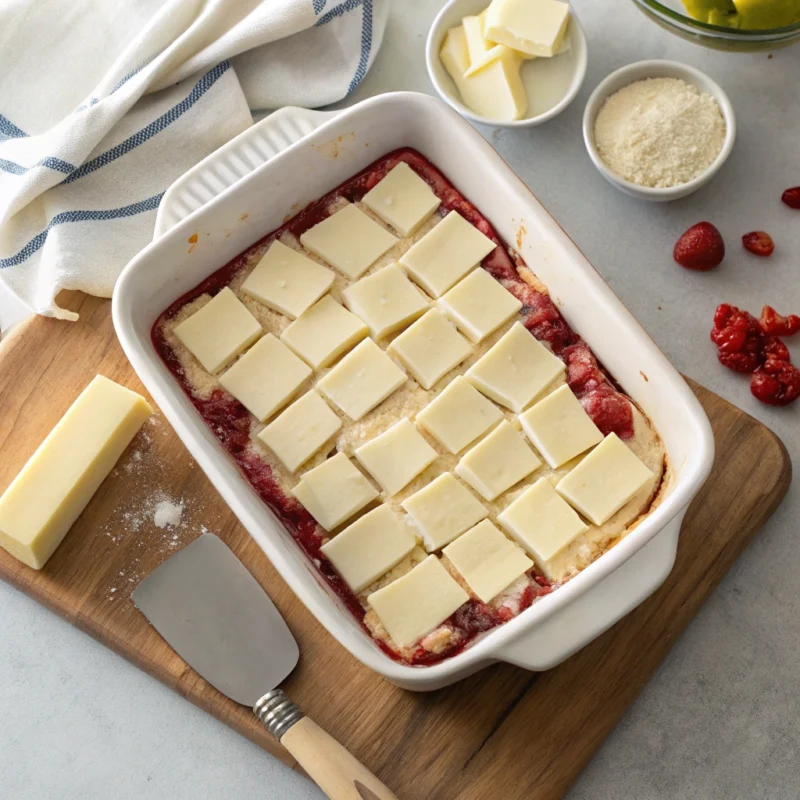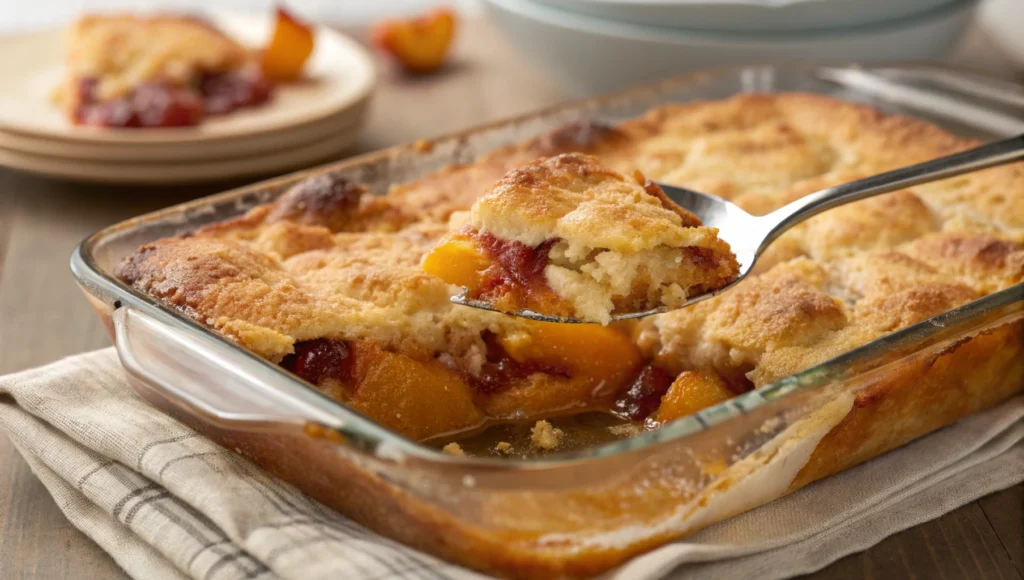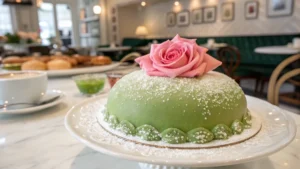
Introduction
Dump cakes are beloved for their simplicity, but sometimes they don’t turn out as expected. A common frustration is ending up with a powdery, uneven texture instead of the rich, golden dessert you envisioned. If you’ve ever asked yourself, “Why is my dump cake still powdery?”, this guide is for you.
We’ll dive deep into the basics of dump cakes, identify common problems, and explore expert tips to perfect this quick and easy dessert. You’ll learn how to fix a powdery cake and avoid mistakes in the future, ensuring a flawless treat every time.
Let’s start by understanding what makes a dump cake special and why it’s such a favorite for home bakers.
What is a Dump Cake?
Understanding the Concept of Dump Cakes
Dump cakes are the epitome of effortless desserts. Unlike traditional cakes, they require no mixing, whisking, or elaborate preparation. You simply “dump” the ingredients into a baking dish, layer them strategically, and let the oven work its magic.
At its core, a dump cake is a cross between a cobbler and a cake. It’s known for its gooey fruit filling at the bottom and a tender, crumbly top layer made from boxed cake mix.
Key Ingredients in Dump Cakes
There are three main components of a dump cake:
- Fruit Filling: This can be fresh fruit, canned fruit, or pie filling. Juicy fruits like peaches, cherries, and apples are popular choices.
- Cake Mix: A boxed mix, usually yellow or white cake, forms the dry layer.
- Butter: Melted or sliced butter is added on top to create a rich, golden crust.
Optional add-ins like nuts, syrups, or chocolate chips can elevate the flavor, but they also require careful balancing to avoid dryness.
Why Dump Cakes Are Popular
Dump cakes are a staple for beginners and busy bakers alike. Here’s why:
- Quick and Easy: No fancy techniques or tools are needed.
- Budget-Friendly: The ingredients are simple and affordable.
- Customizable: You can create endless flavor combinations by switching up the fruit or cake mix.
However, the simplicity of dump cakes can sometimes lead to errors. Skipping a step or misjudging proportions often results in common issues like powdery patches, uneven textures, or dry spots.
Identifying the Powdery Problem
Signs of a Powdery Dump Cake
There’s nothing worse than pulling your dump cake out of the oven only to find that parts of the top are dry, crumbly, or dusty. This frustrating issue often manifests as:
- Dry patches of unbaked cake mix scattered across the surface.
- A gritty or powdery texture that doesn’t blend well with the rest of the dessert.
- Uneven baking, where some sections are golden and moist while others are undercooked.
A visually unappealing and oddly textured dump cake is a common result of small but impactful mistakes in the baking process.
Causes of Powdery Texture
If you’ve ever wondered, “Why is my dump cake still powdery?”, the answer lies in one or more of these culprits:
- Insufficient Moisture: Dump cakes rely on liquid from the fruit filling to saturate the cake mix. When there’s not enough liquid—especially with fresh fruit or low-juice fillings—the mix can’t fully absorb moisture, leaving dry spots.
- Uneven Butter Distribution: Butter is essential for creating a golden crust. If it’s not spread evenly, some areas of the cake mix won’t be moistened or baked correctly.
- Incorrect Oven Settings: Baking at the wrong temperature or for too short a time can cause uneven cooking, leading to a mix of soggy and powdery areas.
- Improper Layering Techniques: Dumping ingredients haphazardly can result in some parts of the cake mix being exposed without enough liquid or fat to bind them.
The Link Between Mistakes and Texture
Small missteps, like using a dry fruit filling or failing to preheat the oven, may seem insignificant at first. But these details can drastically impact the final outcome. To avoid a powdery cake disaster, it’s crucial to identify where things went wrong before making adjustments in the future.
Common Causes of a Powdery Dump Cake
Liquid Content Issues
The most common reason behind a powdery dump cake is a lack of moisture. Cake mix needs liquid to hydrate and bake properly. Here’s how liquid content can go wrong:
- Using Fresh Fruit Without Added Syrup: Fresh fruit alone may not provide enough juice to saturate the dry cake mix. Unlike canned fruit or pie fillings, it lacks the extra moisture needed.
- Choosing a Dry Fruit Filling: Some pie fillings or canned fruits are packed in water rather than syrup, which reduces the available liquid.
- Skipping Additional Liquids: Many recipes assume the fruit filling will be juicy enough, but that’s not always the case. Adding a splash of juice, milk, or cream can make a world of difference.
Butter Problems
Butter plays a dual role in dump cakes: it adds richness and helps bind the dry ingredients. Issues arise when:
- There’s Not Enough Butter: Using less butter than the recipe calls for leaves parts of the cake mix exposed, resulting in dry patches.
- Uneven Butter Distribution: If you melt and pour the butter unevenly, or use large chunks, it won’t cover the entire surface. This leaves some areas dry while others get too much fat.
Baking Temperature and Time
Even if your ingredients are perfect, baking mistakes can still ruin your cake. Here’s how:
- Low Oven Temperature: A temperature that’s too low means the mix won’t fully bake, leaving raw, powdery spots.
- Short Baking Time: Removing the cake too early may leave the top uncooked.
- High Temperature Risks: Conversely, a temperature that’s too high can dry out the top before the rest of the cake is done.
Improper Pan Choice
The type and size of your pan can directly affect how evenly the cake bakes:
- Using a Pan That’s Too Deep: Deep pans can trap steam and prevent the mix from cooking evenly.
- Using a Non-Conventional Pan Material: Glass pans retain heat differently from metal pans, sometimes leading to inconsistent baking.
The Domino Effect of Mistakes
Each of these issues—whether it’s missing liquid, uneven butter, or an unsuitable pan—can snowball into a powdery mess. When you understand these causes, you’re better equipped to bake a perfectly moist and evenly cooked dump cake.
Fixing a Powdery Dump Cake
Distributing Butter Evenly

One of the most critical steps in avoiding a powdery dump cake is ensuring the butter is spread uniformly. This allows the dry cake mix to absorb the fat and bake into a golden, moist crust. Here’s how to do it:
- Slice Butter Thinly: Instead of melting butter and pouring it unevenly, cut it into small, thin pieces. Spread these over the entire surface of the cake mix.
- Use an Even Grid Pattern: Place the butter slices like a checkerboard to ensure every part of the cake mix gets covered as it melts.
If you’re looking for inspiration to perfect buttery desserts, check out this pumpkin dump cake recipe for detailed tips on layering and baking.
Adding Moisture
If your dump cake has dry, powdery areas, the issue often stems from insufficient liquid. Follow these tips to enhance moisture:
- Choose Juicy Fillings: Opt for canned fruits in syrup or pie fillings that provide plenty of liquid to saturate the cake mix.
- Add Extra Liquid: For fresh fruits, mix in a bit of juice, milk, or cream to make up for the lack of natural syrup.
- Drizzle Syrups or Creams: Before baking, pour a small amount of flavored syrup or heavy cream over the top layer. This not only adds moisture but enhances the flavor too.
Temperature and Time Adjustments
Baking your dump cake at the right temperature is non-negotiable. A misstep here can lead to uneven baking and a mix of soggy and powdery areas.
- Preheat Your Oven: Always preheat the oven to 350°F (or the recommended temperature).
- Use the Toothpick Test: Check for doneness by inserting a toothpick into the center. It should come out clean or slightly sticky, never powdery.
- Monitor Baking Time: If the cake top still looks powdery, give it an additional 5–10 minutes in the oven while keeping a close watch.
Preventing Future Baking Issues
To consistently avoid issues, consider these additional tips:
- Use a 9×13 Pan: The right-sized pan ensures even heat distribution.
- Layer Carefully: Spread the cake mix evenly over the filling, then top it with butter slices. Avoid clumps to promote consistent baking.
For more baking inspiration, you might enjoy this perfect peach crumble recipe that shares techniques for achieving moist and flavorful desserts.
Expert Tips for Perfect Dump Cakes
Pre-Mixing Dry Ingredients for Even Results

One effective way to avoid a powdery top layer is to pre-mix part of the dry cake mix with a bit of liquid before layering. This simple tweak helps hydrate the mix and ensures even baking:
- Combine a Small Portion: Mix about ¼ cup of the cake mix with juice or melted butter until it forms a paste.
- Spread the Paste: Layer this on top of the fruit filling before adding the rest of the dry cake mix and butter slices.
This step minimizes dry patches while maintaining the signature dump cake texture.
Choosing the Right Ingredients for Moist Results
Selecting high-quality and complementary ingredients can significantly enhance the final outcome of your dump cake:
- Opt for Trusted Cake Mix Brands: Reputable brands often bake more evenly. Yellow or white cake mixes are great choices for their mild flavor.
- Pair Fruits and Mixes Thoughtfully: Match fruit flavors with a cake mix that complements them. For example, peaches go well with yellow cake, while chocolate pairs beautifully with cherries.
- Enhance Juiciness with Add-Ins: A drizzle of vanilla extract or a sprinkle of brown sugar over the fruit layer can amplify flavor and moisture.
Using Add-Ins Like Fruit Syrup or Cream
Elevate your dump cake by incorporating flavorful additions:
- Fruit Syrups: Add a tablespoon or two of syrup from canned fruit to moisten the dry mix further.
- Heavy Cream or Milk: Drizzle cream over the top layer for a rich, decadent crust.
- Spices and Extras: Sprinkle cinnamon, nutmeg, or even chopped nuts for added depth and crunch.
These small changes not only prevent powdery results but also make the dessert stand out at gatherings.
Bonus Tip: Embrace Experimentation
The beauty of a dump cake lies in its flexibility. Experiment with different fruit combinations, toppings, or even butter substitutes to create new variations.
For more innovative recipes, explore this easy peach cobbler recipe with cake mix, which highlights layering techniques similar to dump cake.
In the final part, we’ll tackle common questions and quick fixes for baking mishaps, ensuring every dump cake you make is flawless.
FAQs
Why is my cake powdery?
A powdery dump cake often occurs due to uneven moisture distribution. This usually happens when the butter isn’t spread evenly, or the fruit filling doesn’t release enough liquid to hydrate the dry cake mix during baking. Additionally, if the cake is underbaked or the oven temperature is too low, the mix might remain dry in spots. To prevent this, ensure your ingredients are layered properly and bake at the recommended temperature.
What is the biggest mistake to avoid when making a dump cake?
The most common mistake is skipping careful layering. Dumping ingredients haphazardly can result in dry areas, uneven baking, or soggy bottoms. Avoid this by:
- Spreading the cake mix evenly over the fruit layer.
- Ensuring butter slices or melted butter cover every inch of the cake mix.
- Using a pan that promotes even heat distribution, such as a 9×13-inch dish.
These small adjustments make a big difference in achieving a perfectly baked dump cake.
How do you know when dump cake is done?
Your dump cake is ready when the top is golden-brown and bubbling. To confirm, insert a toothpick or skewer into the center of the cake. If it comes out clean or with only a few moist crumbs, the cake is done. Be sure to check the edges as well; they should be crisp and slightly caramelized.
How to fix grainy cake mix?
If your cake mix turns out grainy, it may be due to uneven hydration or improper mixing of ingredients. Here’s how to fix it:
- Add Liquid: Drizzle melted butter, cream, or syrup over the grainy areas and let it soak for a few minutes.
- Bake Again: Return the cake to the oven for another 5–10 minutes to allow the liquid to integrate.
- Use a Topping: Cover any remaining grainy spots with whipped cream, ice cream, or a fruit compote for a quick, delicious fix.
By following these steps, you can salvage a grainy mix and turn your dump cake into a satisfying dessert.
Now that you’re armed with solutions, you can confidently tackle the question, “Why is my dump cake still powdery?”, and enjoy consistent, delightful results every time! For more recipes and baking tips, explore Makouri Recipes for inspiration.
Conclusion
Dump cakes are a go-to dessert for their simplicity and versatility, but even the easiest recipes can encounter hiccups. If you’ve ever wondered, “Why is my dump cake still powdery?”, now you have the knowledge to avoid and fix this common issue. By understanding the role of each ingredient, ensuring even distribution, and mastering baking techniques, you can create a perfectly golden, moist, and delicious dump cake every time.
Remember, a few small adjustments—like adding extra liquid, slicing butter evenly, or using the right pan—can make a world of difference. And don’t forget to experiment with flavors and toppings to make each bake uniquely yours.
With these tips and tricks, you’re all set to enjoy a dump cake that’s not just quick and easy, but also consistently delightful. Happy baking! 😊
For more creative dessert ideas, visit Makouri Recipes and discover a world of culinary inspiration.



